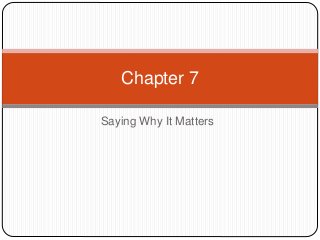
Ch 7: Saying What Matters
- 1. Saying Why It Matters Chapter 7
- 2. So what?! Who cares?! A major problem that occurs in academic writing is when writers don’t address the crucial question of why their arguments matter. In this class and in many of your other classes, you will read a variety of essays and articles. Sometimes, it is clear why these are articles are written. Other times, you might find yourself asking, “Why did I just read this?”
- 3. Read to write, write to read Just like when we read, we ask ourselves: What point is the author trying to make? Or, What is the author’s purpose? The same can be applied when we write: It is important that you explicitly state the purpose of your essay. Therefore, always remember to include the “who cares?” and “so what?” factors in your essay.
- 4. Example from the text… “Scientists used to think body fat and the cells it was made of were pretty much inert, just an oily storage compartment. But within the past decade research has shown that fat cells act like chemical factories and that body fat is potent stuff: a highly active tissue… In recent years, biologists have begun calling fat an ‘endocrine organ,’ comparing it to glands like the thyroid… In this example, the writer has identified who might care about her argument.
- 5. “Who Cares?” Templates To address the “who cares?” factor, we can use several different templates: This interpretation challenges the work of those critics who have long assumed that __________. These findings challenge the work of earlier researchers, who tended to assume that ___________. Recent studies like these shed new light on ___________, which previous studies have not addressed.
- 6. Stop and Reflect: They Say Think back to the last essay you wrote for this class. Can you think of any particular readers who might care about your argument? Whom your argument might affect? The answer isn’t “my professor”! Consider who is participating in that academic conversation. Who is the “They Say”? Might they care?
- 7. “Who Cares?” Continued… The text offers several more templates to incorporate your “who cares?” In many cases, the templates allow for you to be more specific in your people or groups you want to address. By answering the “who cares?” you establish a type of contrast between what others say and what you say that is central. It helps you to create dramatic tension or clash of views in your writing that readers will feel invested in and want to see solved.
- 8. “So What?” In many cases, you won’t have a specific group to address—so answering “who cares?” isn’t enough. You therefore need to answer “so what?” as well. The best way to do this is by appealing to something your readers already care about.
- 9. Checking in with your reader Who has been your primary reader up until this point? If you say your professor, you are correct. How many papers do you think your professor grades? If you say a lot, you are definitely correctly. Your professors read anywhere from 30-120 essays PER assignment…that’s A LOT. And trust me, those papers can get pretty tiring pretty fast… Therefore, you want to check in with us and make sure we are invested in your essay.
- 10. “So What?” Templates Although X may seem trivial, it is in fact crucial in terms of today’s concern over _________. Ultimately, what is at stake here is ____________. These findings have important implications for the broader domain of ____________.
- 11. When does it become redundant? At times, it might seem a little overbearing to address the “so what/who cares?” factor in ALL your writing. We might ask: Is it necessary to state these factors when in some cases our argument and its consequences are quite obvious? The truth is yes—writers should never take for granted the so “what/who cares?” factor in their essays. Writers don’t need always to go on and on, but it’s safest and necessary to answer these questions. When you step back from the text and explain why it matters, you are urging your audience to keep reading and to care.